Understanding Texas Probate Inventory Requirements
In Texas, understanding the probate inventory requirements is crucial for executors and heirs. A probate inventory is a detailed list of a deceased person's assets, including real estate, bank accounts, and personal property, that must be filed with the court. This inventory serves as an essential document to ensure the fair distribution of the deceased's estate according to their will or state law.
Executors are responsible for compiling this inventory within 90 days of their appointment. This includes conducting a thorough assessment of all assets, obtaining appraisals if necessary, and documenting any debts or liabilities. Failure to accurately complete the inventory can lead to legal complications and delays in the probate process.
Common Challenges in Texas Probate Inventory Management
Managing a probate inventory can present several challenges, particularly for those unfamiliar with the legal process. Common issues include locating all assets, determining their value, and addressing disputes among heirs regarding asset distribution. Executors may find it difficult to navigate the complexities of Texas probate law, which can lead to potential delays and increased costs.
Additionally, if the deceased had a diverse portfolio of assets, such as real estate or investments, the executor may need to engage professionals like appraisers or financial advisors to ensure accurate valuations. Understanding these challenges and seeking legal guidance can help streamline the inventory process and mitigate potential conflicts.
The Role of Executors in Probate Inventory Preparation
Executors play a vital role in preparing the probate inventory, as they are tasked with managing the estate's assets and ensuring compliance with legal requirements. Their responsibilities include gathering all relevant information about the deceased's assets, debts, and liabilities, and compiling this data into a comprehensive inventory that must be submitted to the probate court.
In Texas, executors must be diligent in their duties, as they can be held legally accountable for any discrepancies or mismanagement of the estate. This includes maintaining accurate records, communicating with beneficiaries, and addressing any challenges that arise during the inventory process. Properly executing these responsibilities can help facilitate a smoother probate experience for all parties involved.
Key Differences Between Probate and Non-Probate Assets
Understanding the distinction between probate and non-probate assets is essential for anyone navigating the estate planning process in Texas. Probate assets are those that must go through the probate court for distribution, typically including property solely owned by the deceased. In contrast, non-probate assets, such as jointly owned property or assets with designated beneficiaries, pass directly to the heirs without court involvement.
Examples of non-probate assets include life insurance policies, retirement accounts, and trust assets. Recognizing these differences can help individuals plan their estates more effectively, ensuring that their wishes are honored and that the probate process is as efficient as possible.

